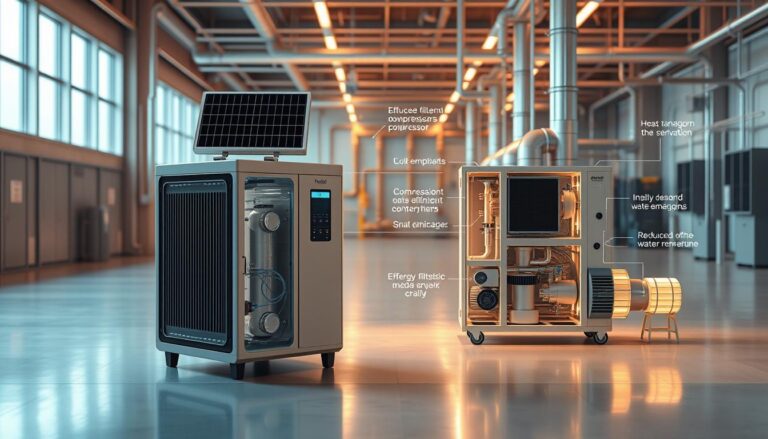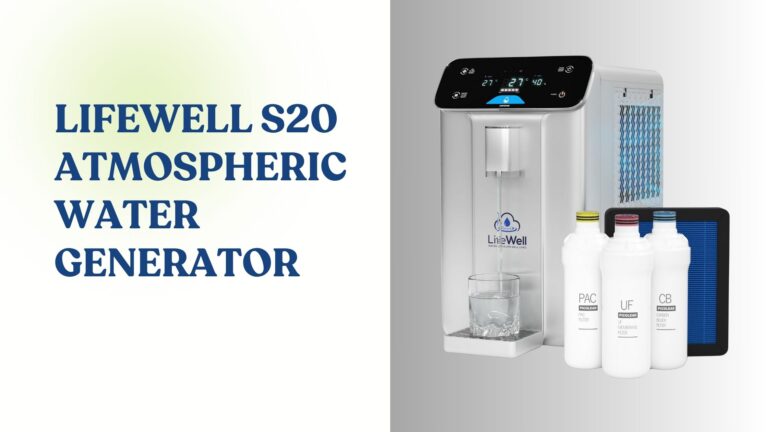Atmospheric Water Generator Explained: How It Works
Can we really extract clean drinking water from air? This question is at the forefront of addressing global water scarcity. Atmospheric water extraction technology has emerged as a viable solution, providing clean drinking water even in areas with limited resources.
The technology behind atmospheric water generators is both innovative and fascinating. By drawing in air, filtering it, and condensing the water vapor, these devices produce clean drinking water. This process not only offers a sustainable source of water but also reduces reliance on traditional water sources and minimizes plastic waste from bottled water.
Key Takeaways
- Atmospheric water generators provide clean drinking water from air.
- The technology involves drawing in air, filtering, and condensing water vapor.
- This process reduces reliance on traditional water sources.
- It minimizes plastic waste from bottled water.
- A viable solution for areas with limited water supply or contamination issues.
What Is an Atmospheric Water Generator?
In a world where water scarcity is a growing concern, Atmospheric Water Generators offer a promising solution by extracting water from humid ambient air. An Atmospheric Water Generator (AWG) is essentially a device designed to extract water from the air, even in relatively dry conditions, and produce clean drinking water.
Definition and Basic Concept
An AWG is a machine that uses the principle of condensation or absorption to extract water vapor from the air. The basic concept revolves around cooling or using desiccants to condense the water vapor into liquid water, which is then processed into potable water. This technology is particularly useful in areas where access to clean drinking water is limited.
History and Development of AWG Technology
The concept of AWGs is not new; ancient civilizations practiced fog collection, demonstrating an early understanding of extracting water from air. Over time, this concept has evolved into sophisticated mechanical systems. Modern AWGs range from simple, passive systems that rely on natural temperature differences to complex, energy-intensive machines that can produce significant amounts of clean water.
The development of AWG technology continues to advance, with ongoing research aimed at improving efficiency, reducing energy consumption, and enhancing water production capabilities. As the technology progresses, AWGs are becoming an increasingly viable solution for addressing water scarcity worldwide.
The Science Behind Atmospheric Water Generator Explained
The technology behind AWGs is rooted in the principles of atmospheric science, specifically the condensation of water vapor. This process is fundamental to understanding how AWGs can provide clean drinking water from air.
Water Vapor in the Atmosphere
Water vapor is a gas present in the atmosphere, and its concentration varies with temperature and humidity. In humid environments, the amount of water vapor is more pronounced, making it easier for AWGs to extract water.
Principles of Condensation
The principle of condensation is key to AWG technology. It involves cooling the air to its dew point, causing the water vapor to condense into liquid water. This atmospheric water vapor condensation tech is the heart of the AWG’s water harvesting process.
Humidity and Its Role in Water Generation
Humidity plays a crucial role in determining the efficiency of an AWG. Higher humidity levels result in higher water production rates, making AWGs more effective in humid climates. Understanding the role of humidity is essential for optimizing the atmospheric water harvesting process.
| Factor | Impact on AWG |
|---|---|
| Humidity Level | Higher humidity increases water production |
| Temperature | Affects the rate of condensation |
| Air Quality | Influences the need for air filtration |
By understanding these principles, we can appreciate the potential of AWGs in providing clean drinking water in various environmental conditions.
Main Types of Atmospheric Water Generators
The versatility of Atmospheric Water Generators is reflected in their various types, designed to optimize water production in different settings. Understanding these types is crucial for selecting the most appropriate AWG for specific needs and environments.
Cooling Condensation Systems
Cooling condensation systems are the most common type of AWG. They work by cooling the air to its dew point, causing the water vapor to condense into liquid water. This method is highly effective in humid environments where the air contains a significant amount of moisture.
Desiccant-Based Systems
Desiccant-based systems use materials that absorb moisture from the air, which is then heated to release the water vapor. This type of AWG is particularly useful in dry climates where traditional condensation methods may not be as effective.
Hybrid Systems
Hybrid systems combine different technologies to optimize water production and energy efficiency. These systems can adapt to various environmental conditions, making them highly versatile.
Combined Cooling and Desiccant Technology
Some hybrid systems integrate cooling condensation and desiccant technologies. This combination allows for more efficient water generation across a wider range of humidity levels.
Energy Recovery Systems
Energy recovery systems are another aspect of hybrid AWGs, designed to minimize energy consumption by recovering and reusing energy within the system. This not only reduces operational costs but also enhances the overall sustainability of the AWG.
As highlighted by industry experts, “The future of water generation lies in the ability to adapt to different environmental conditions, making hybrid systems a promising direction for AWG technology.”
“The integration of multiple technologies in AWGs represents a significant step forward in sustainable water generation.”
In conclusion, the main types of Atmospheric Water Generators offer a range of solutions for different applications and environments. By understanding these types, users can make informed decisions about which AWG is best suited to their needs.
Step-by-Step Process: How Does an Atmospheric Water Generator Work
Understanding how an Atmospheric Water Generator works is crucial for appreciating its efficiency and complexity. The journey from air to clean drinking water involves multiple critical steps.
Air Intake and Filtration
The first step in the atmospheric water harvesting process is air intake. The AWG draws in air from the atmosphere, which then passes through a filtration system to remove dust, pollen, and other pollutants. This step is crucial for ensuring the quality of the water produced.
Condensation or Absorption Process
After filtration, the air undergoes either a condensation process or an absorption process. In the condensation process, the air is cooled to its dew point, causing the water vapor to condense into liquid water. Alternatively, some AWGs use a desiccant material to absorb moisture from the air. The desiccant is then heated to release the water vapor, which is subsequently condensed into liquid water.
Water Collection and Storage
The collected water is then stored in a tank. The storage capacity varies depending on the size and design of the AWG. For more information on the design and fabrication of AWGs, you can refer to research papers such as the one on design analysis and fabrication of atmospheric water.
Purification and Mineralization
The final step involves purifying and mineralizing the water to make it safe and healthy for consumption. This is achieved through various methods, including:
Filtration Methods
Advanced filtration methods are used to remove any remaining impurities. These can include activated carbon filters, reverse osmosis, and other technologies.
UV Treatment and Ozonation
UV treatment and ozonation are used to disinfect the water, killing any bacteria, viruses, or other microorganisms that may be present. This ensures that the water is not only clean but also safe to drink.
The end result of the atmospheric water harvesting process is clean drinking water from air, providing a sustainable and innovative solution for water scarcity issues.
Key Components of an Atmospheric Water Generator
The effectiveness of an Atmospheric Water Generator (AWG) hinges on its key components, which work in harmony to produce clean drinking water.
Air Filters and Fans
Air filters and fans are the first line of defense in an AWG system, drawing in air and removing dust, pollen, and other impurities. Efficient filtration is crucial for protecting the subsequent components and ensuring the quality of the generated water.
Condensation Coils or Desiccant Materials
The heart of the AWG lies in its ability to condense or absorb water vapor from the air. Condensation coils cool the air to its dew point, causing the water vapor to condense into liquid water. Alternatively, desiccant materials absorb moisture from the air, which is then extracted through a regeneration process.
Water Treatment Systems
After water is extracted from the air, it undergoes treatment to remove any remaining impurities. This typically involves UV treatment, reverse osmosis, or other purification methods to ensure the water is safe and clean for drinking.
Control Systems and Sensors
Modern AWGs are equipped with sophisticated control systems and sensors that monitor the air’s temperature, humidity, and quality. These systems optimize the water generation process, adjusting parameters as needed to maximize efficiency and output.
Smart Technology Integration
Some AWG models incorporate smart technology, allowing users to monitor and control the system remotely. This can include features like energy consumption tracking, maintenance alerts, and customizable settings for enhanced user experience.
The integration of these key components makes AWGs a reliable source of clean drinking water, offering a sustainable solution for water generation, especially in areas where traditional water sources are scarce or unreliable.
Benefits and Advantages of AWG Technology
The benefits of AWG technology are multifaceted, providing a sustainable solution for water needs. Atmospheric Water Generators offer a range of advantages that make them an attractive option for various applications.
Environmental Benefits
AWGs contribute to a reduction in the environmental impact associated with traditional water sourcing and treatment. By generating water from air, they minimize the need for water transportation and processing, thus lowering carbon emissions. This aspect is particularly significant in areas where water scarcity is a concern.
Independence from Traditional Water Sources
One of the key benefits of AWGs is their ability to provide clean drinking water independently of municipal supplies. This is especially valuable in regions with poor water quality or during emergency situations where traditional water infrastructure may be compromised.
Water Quality and Purity
The water produced by AWGs is of high quality and purity, making it safe for consumption. The process involves filtration and purification, ensuring that the water is free from contaminants and minerals that are often found in tap water.
Versatility and Adaptability
AWGs are versatile systems that can be adapted to various environments and applications, ranging from small residential units to large industrial systems. Their flexibility makes them suitable for different settings, including disaster relief areas and remote locations.
Key advantages of AWG technology include:
- Reducing reliance on traditional water sources
- Minimizing environmental impact
- Providing high-quality drinking water
- Offering versatility in various applications
As the world continues to face water scarcity challenges, the role of AWGs in providing a sustainable and reliable source of clean drinking water becomes increasingly important.

Practical Applications in the United States
The practical applications of Atmospheric Water Generators in the US are vast and varied. AWGs are being utilized in diverse settings, from residential homes to commercial and industrial facilities, and even in disaster preparedness and emergency response scenarios.
Residential Systems for American Homes
For American homes, AWGs offer a sustainable home water generation system that is both reliable and environmentally friendly. These systems provide households with a consistent source of clean drinking water, reducing dependence on municipal water supplies.
Commercial and Industrial Uses
In commercial and industrial settings, AWGs are valued for their scalability and ability to provide water for various uses. From offices and hotels to manufacturing facilities, these systems help reduce water costs and enhance water security.
Disaster Preparedness and Emergency Response
AWGs play a critical role in disaster preparedness and emergency response. By providing a sustainable water generation solution, they help ensure that communities have access to clean water even when traditional water infrastructure is compromised.
Off-Grid Solutions for Remote Properties
For remote properties, AWGs serve as an effective off-grid solution, providing water independence. These systems are particularly beneficial in areas where traditional water infrastructure is lacking or unreliable.
In conclusion, the versatility and reliability of AWGs make them an attractive solution for a wide range of applications across the United States. Whether for residential, commercial, or industrial use, or for disaster preparedness and off-grid needs, AWGs are proving to be a valuable technology for ensuring access to clean and sustainable water.
Considerations Before Purchasing an AWG System
To make an informed decision about acquiring an Atmospheric Water Generator (AWG) system, several critical considerations must be evaluated. Understanding these factors helps ensure that the chosen system meets specific needs and provides the expected benefits.
Climate Suitability Across US Regions
The efficiency of AWG systems varies significantly with climate conditions, particularly humidity and temperature. Regions with high humidity are generally more suitable for AWG technology. For instance, coastal areas tend to have higher humidity levels, making them more conducive to AWG operation.
Energy Efficiency and Operating Costs
Energy efficiency is a crucial factor as it directly impacts the operating costs of the AWG system. More energy-efficient systems may have higher upfront costs but can lead to significant savings over time.

Maintenance Requirements
Understanding the maintenance needs of an AWG system is vital to ensure it remains operational and efficient. Regular maintenance tasks may include filter replacements and cleaning condensation coils.
Cost-Benefit Analysis
A thorough cost-benefit analysis is essential, including comparisons with traditional water sources and considering the long-term investment perspective.
Comparison with Traditional Water Sources
When evaluating the cost-effectiveness of an AWG system, it’s essential to compare it with traditional water sources. The table below provides a basic comparison.
| Water Source | Initial Cost | Operating Cost | Maintenance |
|---|---|---|---|
| AWG System | High | Variable | Regular |
| Traditional Water Supply | Low | Fixed | Minimal |
Long-term Investment Perspective
While the initial cost of an AWG system may be higher, the long-term benefits, including potential savings on water bills and the value of having a sustainable water source, can make it a worthwhile investment.
Conclusion
Atmospheric Water Generators represent a significant innovation in water production technology, offering a sustainable and reliable source of clean drinking water from air. As the world grapples with water scarcity and quality issues, AWGs provide a viable solution for sustainable water generation.
The versatility of Atmospheric Water Generators makes them suitable for various applications, ranging from residential use to commercial, industrial, and emergency response scenarios. By harnessing water vapor from the air, AWGs provide a clean source of drinking water, reducing reliance on traditional water sources.
As we move forward, the importance of AWGs in ensuring global water security cannot be overstated. Whether you’re considering an AWG for personal use or looking to understand its potential in broader applications, it’s clear that this technology has the potential to make a significant impact on our planet’s water challenges. Atmospheric water generator explained in detail throughout this article highlights its potential in addressing water scarcity and quality issues.







